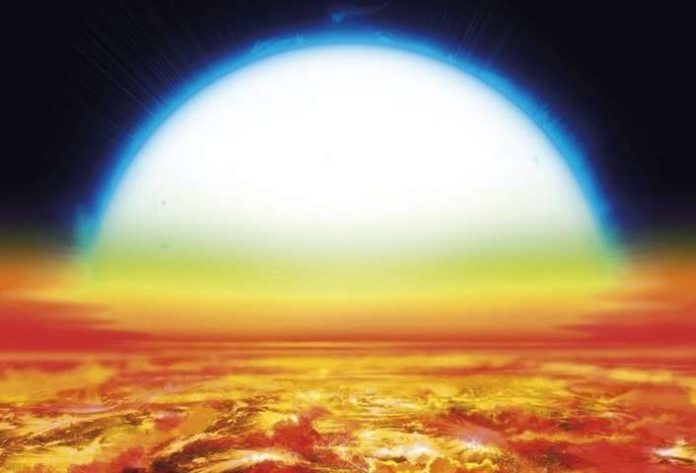For the first time, scientists at the University of Geneva in collaboration with the University of Bern (UNIBE), Switzerland, have discovered the presence of iron and titanium vapors in the atmosphere of an ultra-hot” planet, KELT-9b. As scientists suggest, the surface temperature of this planet has reached more than 4000 degrees.
KELT-9 is a star found 650 light years from Earth in the heavenly body Cygnus (the Swan). With a temperature of more than 10,000 degrees, it is twice as hot as the sun. This star is circled by a giant gas planet KELT-9b, which is 30 times closer than the Earth’s distance from the sun. In light of this nearness, the planet circles its star in 36 hours and is warmed to a temperature of more than 4,000 degrees.
The hottest “ultra-hot” planet was discovered last year by American astronomers. Now, NCCR PlanetS researchers performed a theoretical study on the atmosphere of the planet KELT-9b.
Scientists observed that this planet while it was moving before its host star (i.e. amid a travel). Amid travel, a minor portion of the light from the star channels through the planet’s atmosphere, and investigation of this sifted light can uncover the chemical composition of the atmosphere. This is accomplished with a spectrograph, which isolates white light into its component spectrum. Iron vapor, if present, would leave an unmistakable unique finger impression in the range of the planet.
Kevin Heng, a professor at the UNIBE said, “The results of these simulations show that most of the molecules found there should be in atomic form because the bonds that hold them together are broken by collisions between particles that occur at these extremely high temperatures.”
Using HARPS-North spectrograph, astronomers discovered a strong signal corresponding to iron vapor in the planet’s spectrum.
Jens Hoeijmakers, a researcher at the Universities of Geneva and Bern and lead author of the study said, “With the theoretical predictions in hand, it was like following a treasure map. And when we dug deeper into the data, we found even more,” he adds. The team also detected the signature of titanium in vapor form.”
“This discovery reveals the atmospheric properties of a new class of so-called “ultra-hot Jupiter.” However, scientists believe that many exoplanets have completely evaporated in environments similar to KELT-9b. Although this planet is probably massive enough to withstand total evaporation, this new study demonstrates the strong impact of stellar radiation on the composition of the atmosphere.”
David Ehrenreich, principal investigator with the UNIGE’s FOUR ACES team said, “Indeed, these observations confirm that the high temperatures on this planet break apart most molecules, including those containing iron or titanium. In cooler giant exoplanets, these atomic species are thought to be hidden within gaseous oxides or in the form of dust particles, making them hard to detect. This is not the case on KELT-9b. This planet is a unique laboratory to analyze how atmospheres can evolve under intense stellar radiation.”
This discovery is published in the journal Nature.
